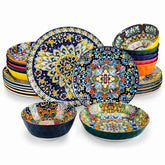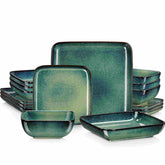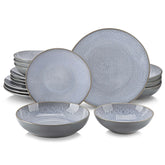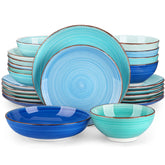Filling the Gaps - A Guide to Using the Empty Space on Dinner Plates
Navigation
- Blank Space And The Significance Of Utilizing It
- Balancing Visual Proportions: How Empty Areas Complement The Food
- Get Creative: Adding Decorative Touches
- Place Utensils: Functional And Aesthetic Considerations
- Pair side dishes: Enhancing the main course
- Allow For Interaction: Creating Space For Condiments And Dips
In the culinary arrangement, food presentation is as important as the taste of the food on the plate. A well-composed plate can enhance the dining experience and provide aesthetic value and practicality. In fact, one of the most subtle yet effective techniques of food presentation is the use of blank space.
Learning how to use the empty spaces on a dinner plate to avoid an untidy plate and instead create a neat and well-arranged plate is essential. In this post, we'll discuss the importance of blank space and provide some ideas on using it effectively in your plating.
Blank Space And The Significance Of Utilizing It
When placing food on a plate, we normally just focus on the food items, but the space around the food is also important. Also known as "negative space," this open area is a basic concept in both art and design and assists in where the diner's gaze should be led. On a dinner plate, blank space serves multiple purposes: it surrounds the dish, makes it look more appealing, and creates a gap between food components. This way, you can make a plain meal look like a gourmet dinner by paying attention to the amount of space left on the plate.
Moreover, blank space makes the plate free from clutter, and every ingredient is easily distinguishable on the plate. A plate filled to the brim may look too much to handle, while a plate with negative space may appear more appealing and tempting. Blank space management is not just about looks; it is much more than that. It also has a functional application; it frees up room for utensils, side dishes, and engaging condiments.
Balancing Visual Proportions: How Empty Areas Complement The Food
Balance is one of the design principles, and the same applies to the plating food. A plate filled to the brim with food can be uncomfortable and oppressive, while a plate with a lot of empty space can also be uncomfortable. The most important thing to achieve equilibrium on the plate is to find a balance between the food and the empty spaces.
The empty spaces surrounding the food can be considered as the 'pause' that lets the viewer focus on the subject, which is your plate. If these spaces are well arranged, then one will get a balance of the positive (food) and the negative (space), which will go a long way in improving the look of the meal. Think about the proportion of food to empty space on the plate. It is generally recommended to fill two-thirds of your plate with food and leave one-third empty. This prevents the diner's eye from being overwhelmed with too much information while dining.
When plating, it is also important to consider the proportions in order to bring out the different textures, colors, and elements of the dish. The gaps make people focus on the details and make all the components look more elegant. This approach keeps the presentation simple while allowing the food to shine on its own.
Get Creative: Adding Decorative Touches
Blank space doesn't have to be completely empty. A dash of creativity here and there can go a long way in making your plate look more appetizing. Empty spaces can be filled with decorative garnishes, flowers, or even mini ornaments, which will turn into artistic decorations that will fit the food. However, it is crucial to make these touches subtle and planned because too many decorations in the room will be counterproductive.
For example, edible flowers are usually used in restaurants that offer gourmet dishes. They complement the dishes and give the meals a more elegant look without overpowering the actual taste of the food. Small herbs such as rosemary sprigs or parsley can also be placed in the corners or at the edges of the plate to give the food freshness and make it look more appealing.
It is also possible to make a small, delicate swirl of the sauce around the empty spots to enhance the refinement of the dish and its taste. However, do not forget that these creative additions should never overwhelm the food because simplicity is the key when it comes to garnishing.
Place Utensils: Functional And Aesthetic Considerations
Another creative way of utilizing empty space on the dinner plate is by placing the utensils on the plate. Instead of putting the fork or spoon in any direction on the table or across the plate, it is possible to align them properly in the open areas of the plate, making the food look neat and presentable.
In some dining experiences, especially in fine dining or modern cuisine, the utensils are placed directly on the plate. This is functional and makes the overall look more professional. The position of utensils should also be considered when plating because it adds to the balance and the direction of the presentation.
For instance, a fork may be placed parallel to the bottom of the plate, thus creating a frame around the food. This can bring a feeling of order and ensure that the diner has access to the utensils while eating.
Pair side dishes: Enhancing the main course
Another practical way to use blank space is to serve side dishes on small plates or to place accompaniments directly on the same plate as the main dish. When sauces, breads or garnishes for side dishes or accompaniments are placed in the gaps, they complement the main dish without overpowering it.
Rather than having excessive things on the plate, small side dishes in ramekin or neatly arranged portions can add other tastes and feel. For instance, if you are preparing a filling steak meal, a small serving of roasted vegetables or a spoonful of herbed butter can be placed in the blank space to enhance the meal. This allows for a balanced presentation and leads the diner on a journey of flavors.
Allow For Interaction: Creating Space For Condiments And Dips
Empty space on a plate can be beneficial in the sense that there is space for the guests to engage with the condiments or sauces. Small dishes for garnishes such as mustard or aioli are also beneficial to the diners as they can control the quantity they want and the dish's feel. This makes the presentation neat and systematic while giving more control over the flavor to enhance the eating experience.
White space on a dinner plate isn't just empty space, but a valuable means for enhancing both the aesthetic and practical aspects of a meal. Thus, one may transform an average dinner into an outstanding dining experience by correcting proportions, decorating a table with some ornaments, positioning cutlery correctly, considering side dishes, and making room for such items.













